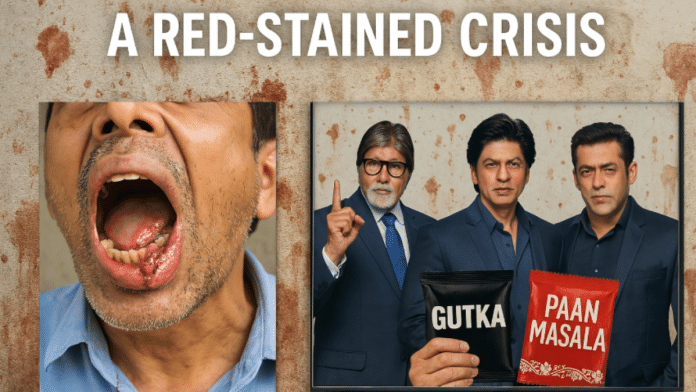Thank you dear subscribers, we are overwhelmed with your response.
Your Turn is a unique section from ThePrint featuring points of view from its subscribers. If you are a subscriber, have a point of view, please send it to us. If not, do subscribe here: https://theprint.in/
Red stains splattered like dried blood on walls, stairwells, and street corners—they resemble the aftermath of a silent massacre. But in India, these sights are not remnants of violence or rebellion. They’re the ubiquitous marks of a nasty national pastime: Paan chewing.
Wrapped in betel leaf and often laced with lime, areca nut, and tobacco, Paan—and its commercial cousin, pan masala—fuels a multi-billion-dollar industry in India.
These products are promoted with aggressive marketing—celebrity endorsements by Bollywood stars and cricketers etc.
But behind the glitz lies a darker reality: skyrocketing rates of youth addiction and oral cancer. Despite bans on advertising, companies use surrogate marketing.
History of the Paan Habit
Paan chewing dates back over 2,000 years. In medieval and Mughal India, paan was a symbol of hospitality and elegance, as seen in poetry, art, and rituals.
But with progress came change. In the 19th century, tobacco began to be added to Paan. Soon, addictive forms had overtaken the traditional paan—ushering in addiction and health consequences on a devastating scale.
What was once a cultural practice is now a public health disaster.
Urban Defacement
While Paan’s aesthetic and medicinal roots once held ritual value, over time, its consumption became more casual and messier.
But in today’s India, the problem isn’t just chewing—it’s the vile ritual of spitting, performed on everything from government offices to newly painted staircase walls. Leaf lovers with crimson teeth leave a trail of red on the nation’s urban face—walls, elevators, corners, sidewalks, overpasses; leaving civic consciousness behind.
An Apartment Complex Tells the Story
Our apartment complex is a microcosm of the country’s contradictions—modern, secure, and yet unable to keep out what corrodes it.
Security guards confiscate nearly 100 packets of gutkha and Paan masala daily. Vendors and workers sneak them in through ingenious means—hidden in socks, phone pouches and even undergarments.
This small community mirrors a nationwide crisis—a society at odds with its own aspirations.
The Oral Cancer Epidemic
The oral cancer epidemic plays out across tea stalls, street corners, and homes with agonising regularity. With over 100,000 people diagnosed annually, it is the most common cancer now among Indian men.
| Form of Tobacco | Increased Risk of Oral Cancer | More Common Cancer Sites |
| Chewing Tobacco | 4–6x | Lips, cheeks, gums, tongue |
| Cigarette Smoking | 2–3x | Tongue, floor of mouth, throat |
| Both Combined | 10x+ | Multiple areas |
Celebrity Complicity
A bitter paradox: India’s biggest icons of health and style—Shah Rukh, Salman—shill cancer in a can. They lend their faces to gutkha and pan masala, often thinly veiled as “mouth fresheners,” .
They know the damage. They know their sway. And still, they cash the cheque.
Surrogate Advertising and Market Expansion
Tobacco advertising is banned in India under the COTPA Act (2003). But brands use surrogate marketing—promoting ‘mouth fresheners’ or bottled water under the same names as their tobacco products.
Conclusion
Paan chewing in India is not just a personal habit—it’s a public health emergency, a civic hygiene crisis, and a moral failing. It stains more than just walls and footpaths; it stains our cities, our public health systems, and our collective conscience. The red blotches that dot every corner of our urban landscape are symbols of a deeper, more systemic rot—made worse by corporate greed, weak enforcement, and celebrity complicity.
To reverse this tide, India needs decisive action across policy, culture, and enforcement. The following steps are essential:
- Enforce anti-spitting laws with real consequences.
Anti-spitting laws must be implemented with sincerity and force. This means clear signage, hefty and consistent fines, video surveillance in hotspots, and public reporting systems. - Ban surrogate advertising that preys on young minds.
We need a complete and uncompromising ban on such surrogate advertising, especially in mass media, sports sponsorships, and entertainment. - Launch public health campaigns that speak with truth and urgency.
We need campaigns that speak with honesty, emotion, and empathy—campaigns that show real survivors, tell real stories, and make the consequences of Paan chewing impossible to dismiss. - Hold celebrities accountable for what they promote.
When celebrities lend their faces to addictive products disguised as “refreshers,” they are not just endorsing brands—they are endorsing a future of disease and dependency. This is not artistic freedom; it’s public harm. We must call out these endorsements loudly and clearly, both in public discourse and in courtrooms. There should be legal and reputational consequences for stars who use their influence irresponsibly.
What’s at stake here isn’t just aesthetics. It’s the lungs, lips, voices, and dignity of millions of Indians—especially the young, the poor, and the naive. By failing to act, we aren’t just standing by—we’re complicit in the growth of a public health crisis.
India can do better. And it must.
These pieces are being published as they have been received – they have not been edited/fact-checked by ThePrint.


